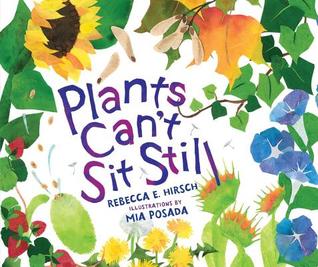
Author Rebecca Hirsch has found something that children and plants have in common - movement. As her text and Mia Posada's illustrations take us through the world of green things, we find that they move in many different ways. The movement of the plants themselves is described, but so is the way in which their seeds travel and find new places to grow. The cut paper and watercolor collages show everything from wispy dandelion seeds floating on the breeze to cockle burrs stuck to someone's hiking socks. The vibrant blue of morning glories shine in the sun on one page while the delicate white petals of moonflowers glow in the night on another. The words of the text are carefully chosen to emphasize the different types of motion - wiggle, squirm, reach, slither, climb, tumble, explode - these are some busy plants.
One of the features that students and teachers will enjoy is the contrasting color in which many of these words are shown. Explode and fling are in green while the rest of the sentence is in blue; or bounce and sprinkle are in red while the rest are in brown. It makes the verbs themselves seem to move and jump off the page to catch your attention. I especially like the way the word "reach" is made with successively larger and larger letters so that the word itself seems to be stretching toward the sky just like the sunflowers in the illustration.
A section entitled "More About Plants"gives more factual information about how and why plants move and seeds are distributed. Then it describes each plant shown in the book, in order of their appearance. Both the common name and scientific classification are given, as well as a description of exactly how each particular plant moves. The back matter includes an author's note, glossary, and suggestions for websites and books to find out more.
This would be an excellent addition to a unit on plants. I can also imagine language arts teachers using it to show their students why word choice matters and how it can bring a text to life, or to have them do a scavenger hunt for all the verbs throughout the book. Perhaps they could even create their own illustrations - combining some scientific observations of the plants around their school and homes with some artistic representations.
Highly recommended for elementary age readers, or for their teachers and librarians. I read an e-book provided by the publisher through NetGalley.
No comments:
Post a Comment